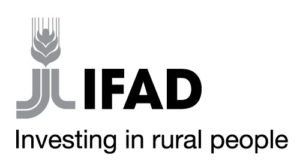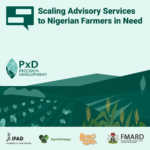Development and Expansion of Nigerian Digital Agricultural Advisory Services for Smallholder Farmers in the context of COVID-19 (DEDAAS)
The DEDAAS initiative is designed to mitigate the impacts of COVID-19 on Nigerian smallholder farmers and to insulate domestic food supply by supporting access to affordable inputs and advisory services to sustain production.
The Development and Expansion of Digital Agricultural Advisory Services for Smallholder Farmers in the context of COVID-19 initiative , is implemented in partnership with the International Fund for Agricultural Development (IFAD) and Nigeria’s Federal Ministry of Agriculture and Rural Development (FMARD). DEDAAS, is PxD’s flagship project in Nigeria and is our first operation in West Africa.
The initiative is implemented as part of a broader grant from IFAD to PxD to support digital extension provision in Nigeria, Kenya and Pakistan. The DEDAAS initiative is designed to mitigate the impacts of COVID-19 on smallholder farmers and to insulate domestic food supply by supporting access to affordable inputs and advisory services to sustain production.

Iterating Scope and Reach
The service has grown in scope and reach since it commenced operations during Nigeria’s Dry Season on 01 February 2021 when it serviced less than 6,000 farmers. During the Wet Season in 2021, Nigeria’s primary growing season, the service pushed agricultural advisory to 107,624 smallholder farmers in eleven states, including conflict-affected areas in Nigeria’s Sahel region. The project serves farmer users in eleven Nigerian states: Borno, Ebonyi, Jigawa, Katsina, Kebbi, Nasarawa, Niger, Ogun, Sokoto, Yobe, and Zamfara.
The service is delivered via push calls coordinated using Paddy, PxD’s inhouse software. Advisory information supports the cultivation of nine priority crops (cabbage, cassava, cowpea, groundnut (peanut), maize, millet, rice, soyabean, and sorghum). Messages are translated and delivered in Hausa, Igbo, and Yoruba and prioritize information on Good Agronomic Practices (GAPs):
- Soil requirements for selected crops
- Climatic requirements for selected crops
- Land preparation for selected crops
- Sowing/planting methods for selected crops
- Fertilizer Management
- Integrated Pest and Disease Management
- Disease management – Bacteria, Fungi, and Virus
- Key Pests and Diseases management for selected crops
- Good Harvest practices
- Good Post-harvest practices
The service has been built by PxD, in partnership with IFAD. At the conclusion of the pilot, PxD will transfer the service to the IFAD country program.
The project was previously known as the Nigeria Rural Poor Stimulus Facility (RPS)
The audio above is an example of a call pushed to farmers growing groundnuts (peanuts). The translated text is as follows:
Soil Requirement for Groundnut
Well-drained, sandy loam soil, with high nutrients are ideal for growing groundnuts. Do not plant groundnuts in clayey soil, which are too heavy, and may lead to difficulties in harvesting. Properly managed soil, with good tillage practice, will give the crop deep roots which result in good nut production and higher yields for the groundnut farmer. It is good to conduct proper soil testing to get information about the quality of your soil and nutrient levels before planting your groundnut seeds. In the absence of any soil testing agents, you can determine the quality of your soil by simply taking note of the weeds or other plants that are growing on the land before clearing it. If you observe many broadleaf weeds on the land, this is a good sign that the soil is good for groundnut cultivation. Another physical way to check for the quality of your soil is to check if it smells. Rich soils will smell like dirt, while bad soils will have no smell at all.
The audio above is an example of a call pushed to farmers growing rice. The translated text is as follows:
Soil Requirement for Rice
Grow your rice in soils with good water retention capacity and high clay and organic matter content. These soils are most ideal for rice cultivation. Proper tillage practices will give rice deep roots which results in better seed production and a higher yield for the farmer. It is good to conduct proper soil testing to get information about the quality of your soil and nutrient levels before planting your rice seeds. In the absence of any soil testing agents, you can also determine the quality of your soil by simply taking note of the number of weeds or other plants that are growing on the land before clearing it. If you observe grassy weeds on the land, this is a sign that the soil is good for rice cultivation. Another physical way to check the quality of your soil is to check if it smells. Rich soils will smell like dirt, while bad soil will have no smell at all.




